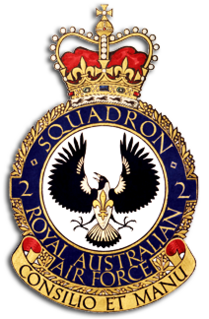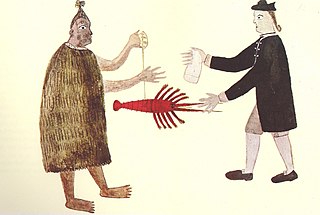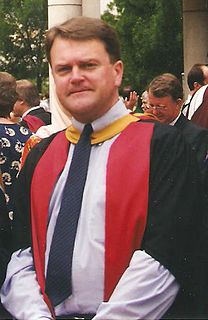
The Australian Army is the military land force of Australia. Formed in 1901, as the Commonwealth Military Forces, through the amalgamation of the Australian colonial forces following federation; it is part of the Australian Defence Force (ADF) along with the Royal Australian Navy and the Royal Australian Air Force. While the Chief of the Defence Force (CDF) commands the ADF, the Army is commanded by the Chief of Army (CA). The CA is therefore subordinate to the CDF but is also directly responsible to the Minister for Defence. Although Australian soldiers have been involved in a number of minor and major conflicts throughout Australia's history, only during the Second World War has Australian territory come under direct attack.

The Royal Australian Air Force (RAAF), formed in March 1921, is the aerial warfare branch of the Australian Defence Force (ADF). It operates the majority of the ADF's fixed wing aircraft, although both the Australian Army and Royal Australian Navy also operate aircraft in various roles. It directly continues the traditions of the Australian Flying Corps (AFC), formed on 22 October 1912. The RAAF provides support across a spectrum of operations such as air superiority, precision strikes, intelligence, surveillance and reconnaissance, air mobility, space surveillance, and humanitarian support.

The Malayan Emergency was a guerrilla war fought in the Federation of Malaya from 1948 until 1960. Pro-independence fighters of the Malayan National Liberation Army (MNLA), the military wing of the Malayan Communist Party (MCP) fought against the armed forces of the British military and Commonwealth. The war was fought over attempts by communist forces to gain independence for Malaya from the British Empire and to establish a socialist economy. The fighting spanned both the colonial period and the creation of an independent Malaya (1957). Although it was referred to as "The Emergency" by colonial authorities, the MNLA referred to it as the "Anti-British National Liberation War". The conflict was called an "Emergency" by the British for insurance purposes, as London-based insurers would not have paid out in instances of civil wars.

The Distinguished Service Order (DSO) is a military decoration of the United Kingdom, and formerly of other parts of the Commonwealth, awarded for meritorious or distinguished service by officers of the armed forces during wartime, typically in actual combat. Since 1993 it has been awarded specifically for 'highly successful command and leadership during active operations', with all ranks being eligible.

Edward "Ted" Kenna, VC was the last living Australian Second World War recipient of the Victoria Cross, the highest decoration for gallantry "in the face of the enemy" that can be awarded to members of the British and Commonwealth armed forces.

The Royal Australian Regiment (RAR) is the parent administrative regiment for regular infantry battalions of the Australian Army and is the senior infantry regiment of the Royal Australian Infantry Corps. It was originally formed in 1948 as a three battalion regiment; however, since then its size has fluctuated as battalions have been raised, amalgamated or disbanded in accordance with the Australian government's strategic requirements. Currently, the regiment consists of seven battalions and has fulfilled various roles including those of light, parachute, motorised and mechanised infantry. Throughout its existence, units of the Royal Australian Regiment have deployed on operations in Japan, Korea, Malaya, Borneo, Vietnam, Somalia, Rwanda, Cambodia, East Timor, the Solomon Islands, Iraq and Afghanistan.
A war correspondent is a journalist who covers stories first-hand from a war zone. They were also called special correspondents.

The military history of Australia spans the nation's 230-year modern history, from the early Australian frontier wars between Aboriginals and Europeans to the ongoing conflicts in Iraq and Afghanistan in the early 21st century. Although this history is short when compared to that of many other nations, Australia has been involved in numerous conflicts and wars, and war and military service have been significant influences on Australian society and national identity, including the Anzac spirit. The relationship between war and Australian society has also been shaped by the enduring themes of Australian strategic culture and its unique security dilemma.

The Australian Army Training Team Vietnam (AATTV) was a specialist unit of military advisors of the Australian Army that operated during the Vietnam War. Raised in 1962, the unit was formed solely for service as part of Australia's contribution to the war, providing training and assistance to South Vietnamese forces. Initially numbering only approximately 30 men, the size of the unit grew several times over the following years as the Australian commitment to South Vietnam gradually grew, with the unit's strength peaking at 227 in November 1970. Members of the team worked individually or in small groups, operating throughout the country from the far south to the Demilitarized Zone (DMZ) in the north. Later they were concentrated in Phước Tuy Province as Australian forces prepared to withdraw from Vietnam. It is believed to be the most decorated Australian unit to serve in Vietnam; its members received over 100 decorations, including four Victoria Crosses, during its existence. The unit was withdrawn from Vietnam on 18 December 1972 and was disbanded in Australia on 16 February 1973. A total of 1,009 men served with the unit over a period of ten years, consisting of 998 Australians and 11 New Zealanders.

The 3rd Battalion, The Royal Australian Regiment is a mechanised infantry battalion of the Australian Army, based in Kapyong Lines, Townsville as part of the 3rd Brigade. 3 RAR traces its lineage to 1945 and has seen operational service in Japan, Korea, Malaya, Borneo, South Vietnam, Rifle Company Butterworth, East Timor, the Solomon Islands, Afghanistan and Iraq.

No. 2 Squadron is a Royal Australian Air Force (RAAF) squadron that operates from RAAF Base Williamtown, near Newcastle, New South Wales. From its formation in 1916 as part of the Australian Flying Corps, it has flown a variety of aircraft types including fighters, bombers, and Airborne Early Warning & Control (AEW&C). During World War I, the squadron operated on the Western Front conducting fighter sweeps and ground-attack missions. It was disbanded in mid-1919, following the end of hostilities. The squadron was briefly re-raised in 1922 as part of the newly independent RAAF, but was disbanded after only a couple of months and not reformed until 1937. It saw action as a bomber unit in the South West Pacific theatre of World War II and, equipped with English Electric Canberra jets, in the Malayan Emergency and the Vietnam War. The squadron was again disbanded in 1982, following the retirement of the Canberra. It was re-formed in 2000 to operate the Boeing 737 AEW&C "Wedgetail". One of the six Boeing 737s was deployed to the Middle East in September 2014, as part of Australia's contribution to the military coalition against ISIS.

The military history of New Zealand is an aspect of the history of New Zealand that spans several hundred years. When first settled by Māori almost a millennium ago, there was much land and resources, but war began to break out as the country's carrying capacity was approached. Initially being fought with close range weapons of wood and stone, this continued on and off until Europeans arrived, bringing with them new weapons such as muskets. Colonisation by Britain led to the New Zealand Wars in the 19th century in which settler and imperial troops and their Māori allies fought against other Māori and a handful of Pākehā. In the first half of the 20th century, New Zealanders of all races fought alongside Britain in the Boer War and both World Wars. In the second half of the century and into this century the New Zealand Defence Force has provided token assistance to the United States in several conflicts. New Zealand has also contributed troops extensively to multilateral peacekeeping operations.

1st Battalion, Royal Australian Regiment is a regular motorised infantry battalion of the Australian Army. 1 RAR was first formed as the 65th Australian Infantry Battalion of the 34th Brigade (Australia) on Balikpapan in 1945 and since then has been deployed on active service during the Korean War, the Malayan Emergency, the Vietnam War, Unified Task Force in Somalia, East Timor, Iraq War and Afghanistan. Additionally, the battalion has deployed on peacekeeping and other operations to a number of countries including Japan, Rifle Company Butterworth, Timor Leste, Solomon Islands, Tonga and the Philippines. In 2021, 1 RAR remains one of the Australian Army's most heavily deployed units sending individuals and detachments to domestic, regional and other enduring operations. The battalion is currently based in Coral Lines at Lavarack Barracks, Townsville, Queensland, where it forms part of the 3rd Brigade.

The 2nd Battalion, Royal Australian Regiment is an amphibious light infantry battalion of the Australian Army part of the 1st Division Amphibious Task Group based at Lavarack Barracks in Townsville.

Lieutenant Colonel Harry Arthur Smith SG, MC is a former senior officer in the Australian Army, seeing service during the Malayan Emergency and the Vietnam War. He was Officer Commanding of D Company, 6th Battalion, Royal Australian Regiment during the Battle of Long Tan on 18 August 1966.
General Peter Courtney Gration is a retired senior Australian Army officer who served in the positions of Chief of the General Staff (1984–87) and Chief of the Defence Force (1987–93), the professional head of the Australian Army and Australian Defence Force, respectively.

The 7th Signal Regiment is an Australian Army signals intelligence (SIGINT) unit. Drawing lineage from the Australian Special Wireless Group (ASWG), which was raised during World War II, the regiment's history includes service in the Allied campaigns in Greece, on Crete and in Syria before taking part in the fighting against the Japanese in New Guinea. After the war, the ASWG was redesignated the 101 Wireless Regiment, deploying detachments overseas during the Malayan Emergency and Confrontation. In the mid-1960s, the unit became the 7th Signals Regiment, taking part in the Vietnam War. The unit is currently part of the 6th Brigade.

The Official History of Australia's Involvement in Southeast Asian Conflicts 1948–1975 covers Australia's involvement in the Malayan Emergency, Indonesia–Malaysia confrontation and Vietnam War. The series is an official history and was funded by the Australian Government and published by Allen & Unwin in association with the Australian War Memorial. Peter Edwards was appointed the official historian for the series in 1982. The series comprises nine volumes, which were published between 1992 and 2012. A single-volume summary of the series, Australia and the Vietnam War, was published in 2014.

Jeffrey Guy Grey was an Australian military historian. He wrote two volumes of The Official History of Australia's Involvement in Southeast Asian Conflicts 1948–1975, and several other high-profile works on Australia's military history. He was the first non-American to become the president of the Society for Military History, but is perhaps best known as the author of A Military History of Australia.

Colonel George Radford Warfe, was an Australian Army officer who commanded several Australian commando and infantry units during the Second World War. He later served in staff and training roles in the post war period, which included service during the Malayan Emergency and then as a civilian advisor during the Vietnam War following his military retirement. He was active in the civil defence organisation in Victoria and in the business community before his death at the age of 63 in November 1975 from cancer.

















